- What we do
- Services
- Solutions
- Our Works
- Company
- Contact Us
August 16, 2022
How Deep Linking Can Help Your App Grow
Every software wants to engage users, because engaged users are more likely to become brand loyalists, creating trust and emotional connection with your brand. This article is about how you can use deep linking technology to engage existing users and attract new ones.
The old rule of thumb is that it costs x5 more to get a new customer than it does to keep an existing one. There are plenty of ways to engage them, and one of the best ways is using a deep linking solution.
Check out our article to find out how deep linking can help your app!
Mobile apps for most businesses are now just as important as websites were ten years ago. The number of mobile device users is only growing, as is mobile app activity.
In 2022, there were 7.26 billion mobile users, and it is expected to hit 7.7 billion by 2027. The amount of time spent on mobile apps impresses as well. According to the Bureau of Labor Statistics, Americans spent an average of 4.1 hours a day on mobile devices in 2021, with a total 3.8 trillion hours.
It’s no wonder that app developers and marketers want to get a piece of customer’s attention. There are many ways to do so and make your app engage users more effectively, integrate better with other communication channels, and ultimately generate more revenue. Mobile deep linking is one of them.

What is a mobile app deep linking?
So, how does deep links differ from regular ones? A regular link leads to the mobile app and will send you to the main page of it if you have the app installed. In other words, deep links send users directly to a specific place on an app, that’s why they are called “deep”.
What kind of a “specific” destination? It can be everything but the app’s home screen.
If you don’t have the app, a deep link will bring you to Google Play or App Store. We’re sure you've seen and used such links before.
What are the uses of deep links?
The mobile deep linking method is an important element of any mobile marketing campaign. It allows you to simplify the path to content for a new audience and improve the user experience for existing users. You remove all the barriers that the client must pass to achieve the final goal, which is increased conversion rate and revenue.
One of the biggest benefits that mobile deep linking brings to mobile app developers is that it can reach potential customers almost everywhere–from QR codes to email campaigns.
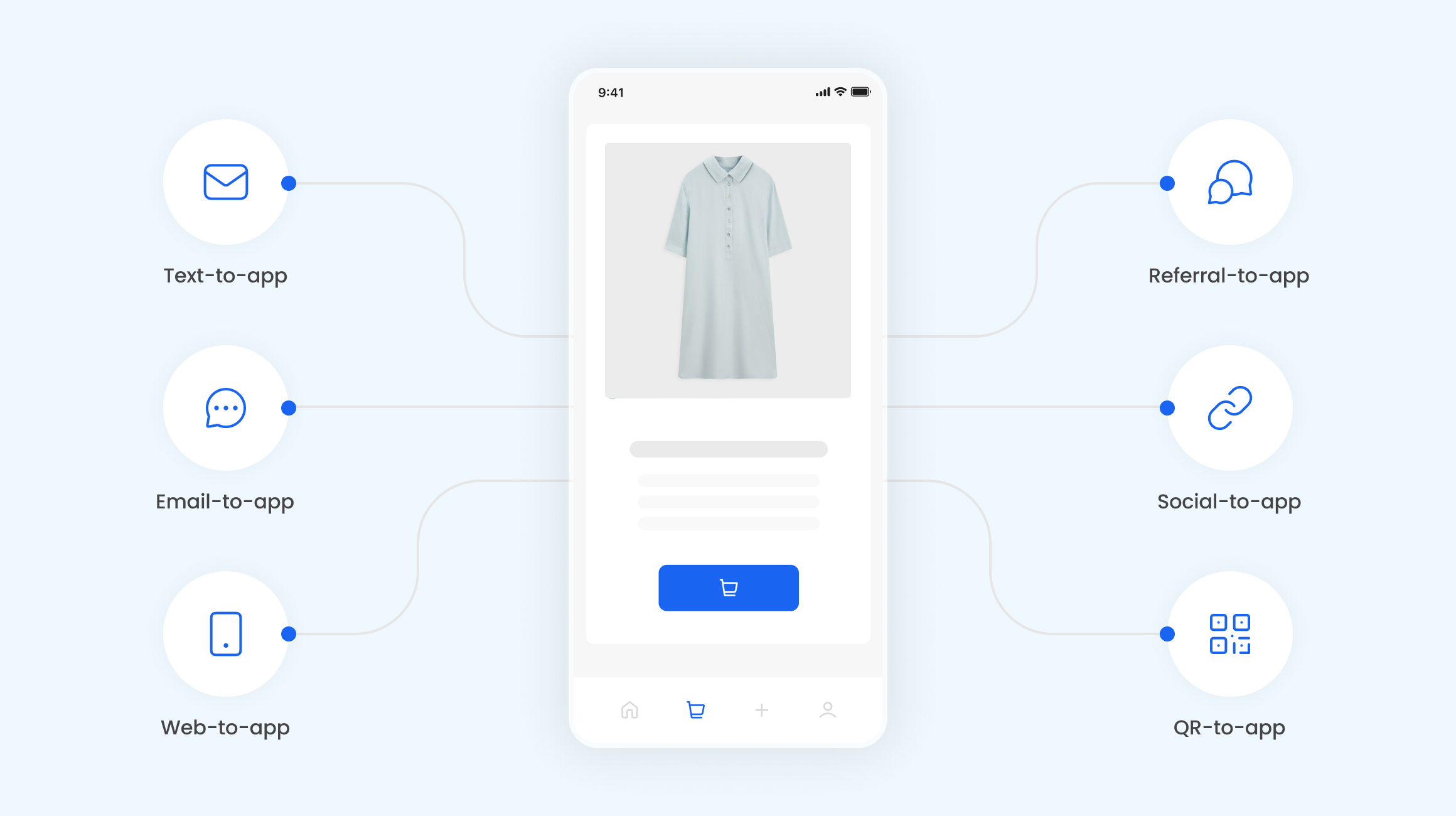
At the same time, deep links are also a powerful analysis tool. You can use them to gather valuable information about your most effective advertising channels, promotions, newsletters, and notifications, as well as the categories of users who most often click on links. That will help you target your audience correctly and make your marketing campaign even more effective.
An additional advantage is that deep links leading to specific screens in your app can be indexed by Google and displayed in search results. Just make sure that the links in the app and on the site match so that users who view the Google search results from the mobile device where your app is installed will be able to go directly to it. This, in turn, helps you increase your indexing rating in search results.
There are several types of deep linking:
- Default deep linking
Default deep linking serves to provide personalized content to existing users who have already installed the mobile app.
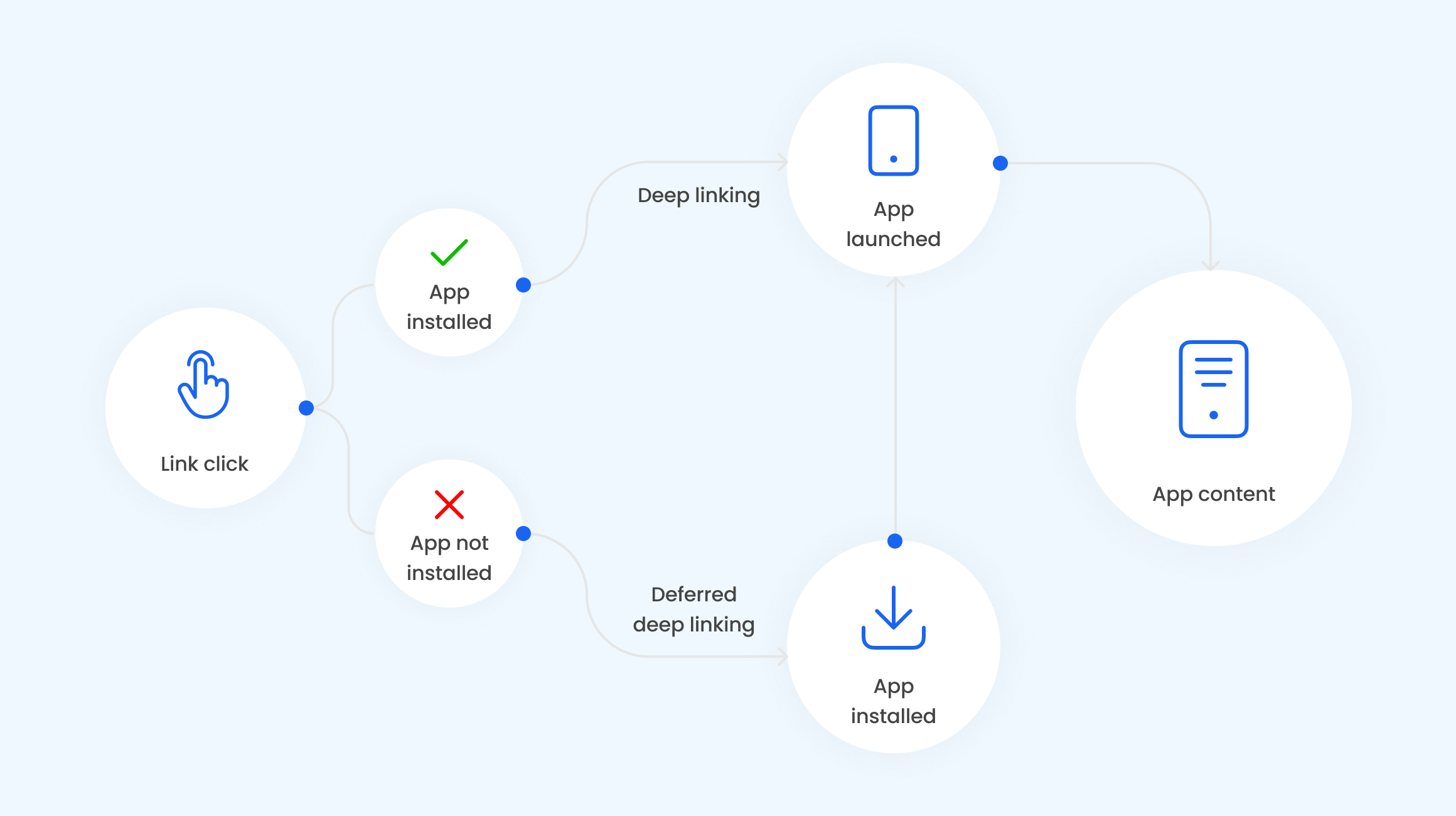
- Deferred deep linking
This kind of deep linking provides personalized content to new or former users immediately after installing the mobile app.
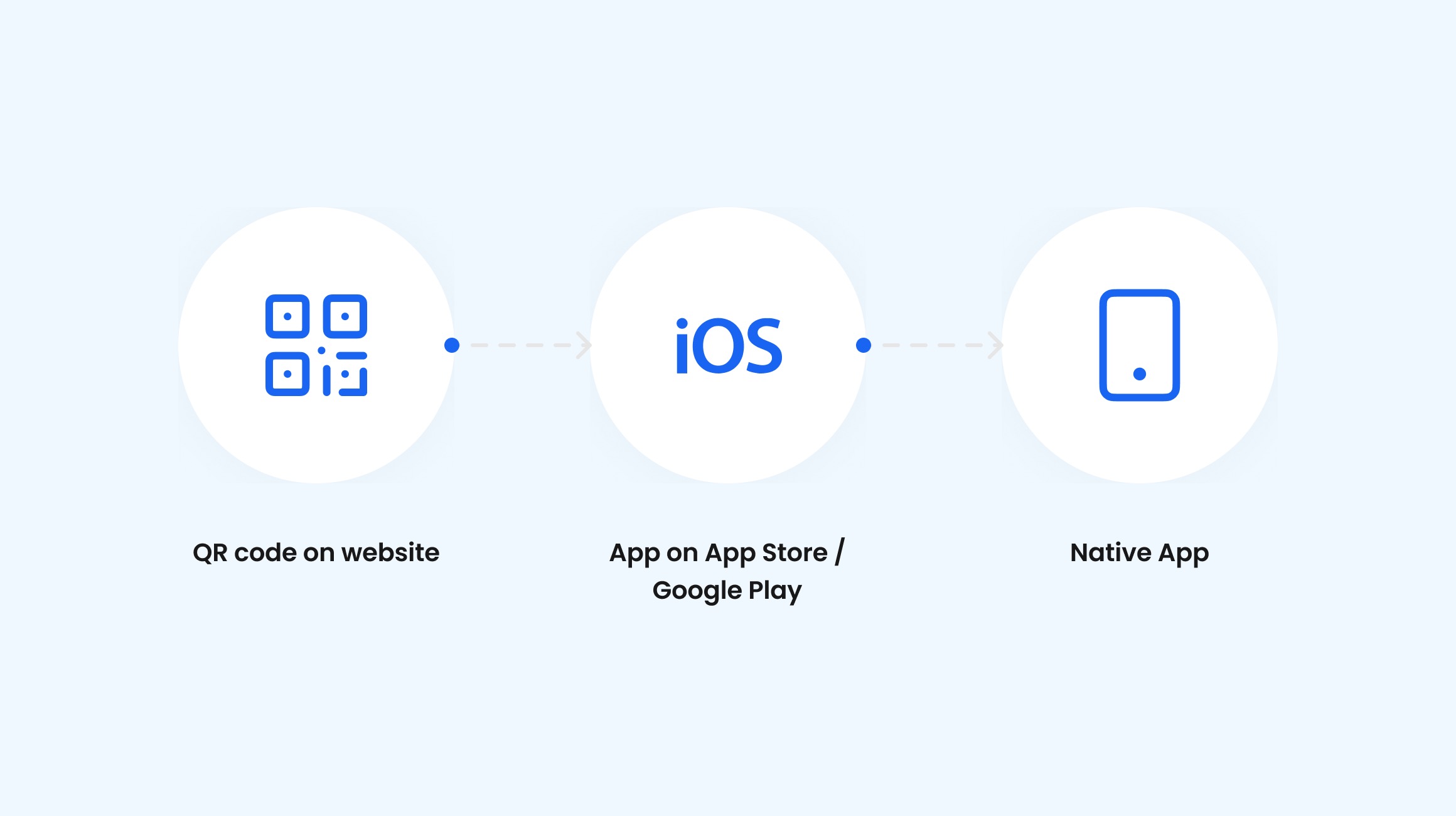
If your company's business area is offline — for example, you have retail outlets or attend trade fairs — deep links can also be useful. Deep links can be embedded in QR codes or Bluetooth beacons. You can direct customers who visited the store’s screen of the desired promotion to create another channel for attracting users to the app.
- Contextual deep linking
With this type of mobile deep linking, developers can provide users with a more personalized app experience after they open an app from a link. They can infer data from these links that take users to a customized welcome screen after they download the app.
Use cases of Default deep linking, Deferred deep linking and Contextual deep linking
Now when you have an idea of what is deep linking and where it can be used, let’s look at the specific use cases by industries.
Default deep linking for e-commerce
1. Cart abandonment
These are two words that make the retailers sad and perhaps even panicking. According to the Baymard Institute research, almost 70% of online shopping carts are abandoned. It sounds crazy: for every 100 customers, 70 of them leave without making any purchase.
However, they’re in luck with deep linking. Retailers can send a cart abandonment email that leads users to their checkout page to remind them about items that they left.

2. Friend referrals for games
You trust your loved ones more than ad and marketers, right? And it’s more likely that you’ll install the app that your friends recommend to you. This purely logical behavioral pattern was the subject of Nielsen’s study that reports a not-so-surprising fact: word-of-mouth recommendations are the most trustworthy source of information. People are four times more likely to buy when referred by a friend.
They can do so via a simple message that contains a deep link. Then you click on it and install the app. Yes, it’s that simple.
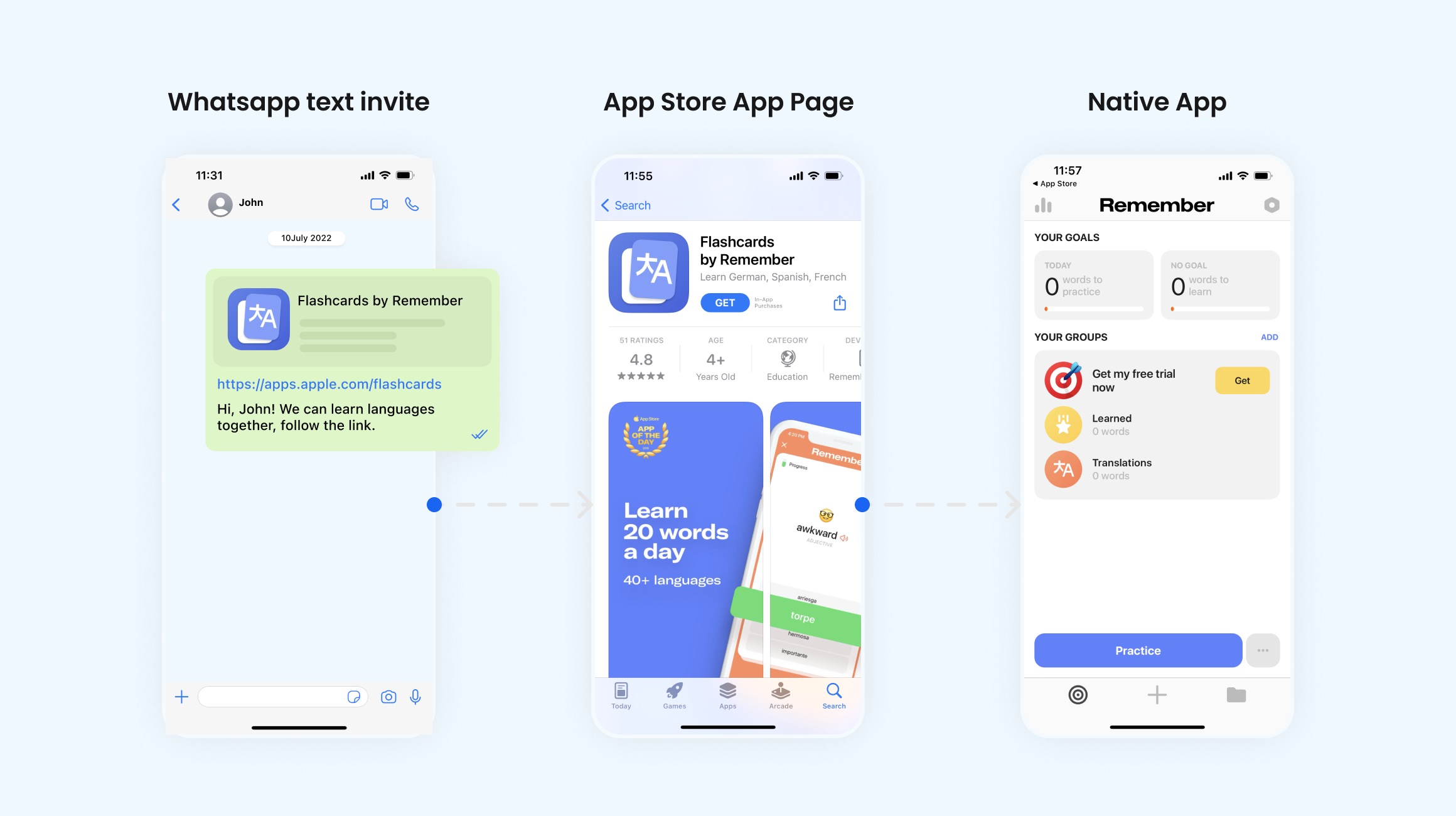
3. Process abandonment (actually, the logic applies to any service business)
Digital journey may include several steps. The rule of thumb is that the more steps it takes to perform a desired action, the more likely users are to drop off.
In other cases, users can be distracted by other things and just forget about your app. In both cases, you can send them a push notification with a deep link that leads users to a specific place on an app.
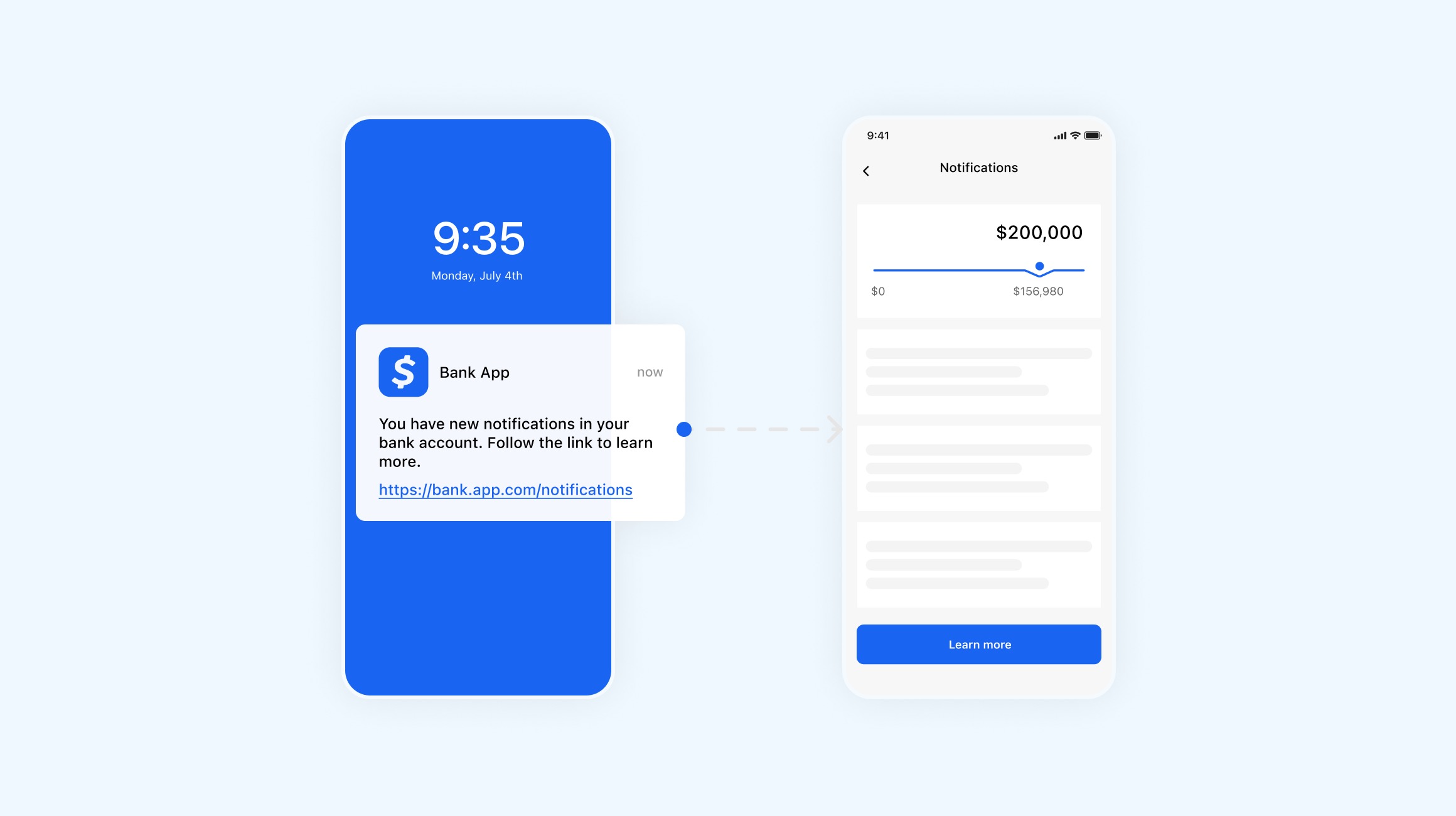
Use cases of deferred deep linking
1. Mobile migration
Imagine your business has a loyal customer base that uses your product or service via a website, but now you have an app and want your clients to use it and interact with your app’s content. Sounds great since deep linking can help to make this migration easy and smooth. You can integrate QR code on the homepage of your website. This QR will lead your clients to Google Play or App Store.
Mobile app deep linking can be helpful when you launch a new product using landing page and want to lead users to your app.
2. In-store conversion in commerce
You may have a brick-and-mortar shop alongside an e-commerce store, and want your clients to make the most of it. Cool! Here comes one example to illustrate how deferred deep links can help you achieve this quite an ambitious goal.
You can place QR codes near items in your store so your potential customers could scan it and check out the information they need, like reviews or user-generated content, to make an informed decision. This serves as a great tool to increase retention rate.
Use cases of contextual deep linking
Contextual deep linking can be used to automatically apply a promotional code or to take people to a specific product in a mobile app retail environment. That said, unlike direct users, deep linked users jump into the right place, without spending time navigating the app.
Universal links (iOS), App links (Android): what is the difference?
The answer is quite obvious: both refer to the same mechanism of driving users to the specific in-app content; Universal links serve Apple users while App links are for Android OS users.
Both universal links and App links bring the benefits of using mobile app deep linking.
How does the deep linking solution work?
The principle of deep linking solution is as follows:
📌The user initiates a click on the URL, causing the resource located at this URL to determine the user’s operating system and make the transition to the application according to a pre-defined pathway.
📌If you look at it in more detail, after clicking on the link, the application does not immediately open the specific section that the link should lead to, but instead goes all the way from the main window to this tab unnoticed by the user. Thus, the user gets the impression that they were immediately redirected to the desired tab, which is the main purpose of deep links.
📌If you set up deep linking using services such as AppsFlyer, you will encounter a concept like OneLink.
📌OneLink acts as a link between advertising and the mobile app. This link may launch an application and pass the developer the data necessary to personalize the interaction with the user. To use these features, you only need to provide the necessary parameters and infrastructure in the mobile app to support deep links.
Most often, deep links and OneLink are used to re-engage existing and former users, i.e. for retargeting.
Why mobile deep linking is cool
There are many reasons why mobile deep linking has become an absolute must-have in a mobile marketer’s arsenal. The advantages of using mobile app deep linking include the following:
- Streamlined users experience
- Unbreakable user funneling
- Better SEO
- Better analytics
Deep linking is the easiest way to guide the user from notifications directly to the desired app screen. In integration with Google Analytics Mobile App Metrics services, it's also used for setting up full-fledged notification campaigns and evaluating their effectiveness. All promotions, sales, and newsletters become much more effective.
You can create cross-channel campaigns by embedding deep links in other apps, emails, banners on websites, or text messages.
Deep links can be indexed by Google and appear in search results. This means that you can access the app directly from the search engine.
You can collect statistics and track the performance of various channels and analyze customer behavior inside the app after a click.
Speaking about analytics, deep links are useful because they collect and transmit data about:
📌views, clicks, and installations
📌channels that generate the most downloads and revenue
📌users who are more likely to click on links
Deep linking solutions
There are different solutions for creating deep links. These services include Adjust, Yozio, Deeplink, open source solutions, Branch, and AppsFlyer, which was already mentioned earlier. In our case, we were interested in the last two of this list.
Branch is one of the most advanced services for working with deep links. We studied it as a leader in its segment.
AppsFlyer is a system that was used to work with marketing campaigns and collect statistics in the app long before the idea of implementing deep links.
If you've got any questions, just contact us and we'll be right there for you
Your friends at YellowBranch is probably the most feature-rich service for implementing deep links, which can do almost everything.
What we liked:
- the richness of features
- quality and convenience
- the high number of examples, detailed user cases, and a blog with useful articles
AppsFlyer is a service that is primarily aimed at marketing campaigns and attracting users to the app. It was used to set up ad campaigns in the app, so we considered it as a logical platform for implementing deep links. AppsFlyer offers its own deep link solution called OneLink.
In AppsFlyer, we liked everything related to marketing campaigns in one way or another.
As a result, our team chose to focus on AppsFlyer–the advanced deep linking solution.
Our experience with AppsFlyer
Our team also uses deep linking, and for more convenient use, we decided to use both AppsFlyer and Branch. After working with and comparing the use of these two services, we decided to choose the first one.
The most notable example of our team working with AppsFlyer was the experience with CashChat, where it's used for referral links. Thanks to mobile deep linking, every CashChat user can go to a specific screen and declare that they want to share this app. To do this, a link is generated that contains a large number of parameters, including those that are responsible for opening the app and leading the user to the desired screen. After a referral link is shared with the user, the user clicks on it.
If a person is already using the app, they will simply be directed to the appropriate page. If a person has downloaded the app but is not logged in, they will be asked to log in and then redirected to the required page. In the same case, if the person has not yet registered in the app, they will be asked to download the app and create a new account. When creating a new account, the user will receive a certain amount of in-game currency, and our developers will get their bonuses from new accounts in the app.
Additionally, AppsFlyer helps us track the number of clicks on referral links and evaluate the number of created links in general. This is a very effective tool for our analytics.
Conclusion
When you go to a website or app, it's sometimes difficult to find the right information or section quickly. This is why it's very important to look at the work of your product through the eyes of the consumer: Surely you would like to get the necessary information in one click.
If so, you should start implementing mobile deep links in your user engagement campaigns now. Do not advertise in your posts and banners what users can hardly find in the menus of your apps.
The fewer steps an existing user needs to complete to get to the desired app page, the higher the chance of a conversion.
May deep linking serve you well!
✔Read also:
Mobile App Development Trends You Should Pay Attention to in 2022
AI in Fintech: Everything You Need to Know
Got a project in mind?
Fill in this form or send us an e-mail
🔗What is deep linking?
🔗Is deep linking effective?
🔗Where deep linking is used?
🔗What are the tools to create deep links?
Subscribe to new posts.
Get weekly updates on the newest design stories, case studies and tips right in your mailbox.
